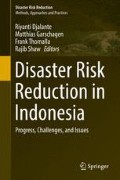Abstract
Disaster risk communication is a fundamental part of disaster management. Knowing who the senders and receivers of risk information are, what constitutes necessary risk information, and how to appropriately convey risk information to trigger actions towards risk reduction, still remains challenging for risk information processes. The aim of this study is to identify the role of Faith-Based Organizations (FBOs) in Bandung, Indonesia as risk communicators through FBOs SIERA framework. A set of indicators in social, economic and institutional resilience activities (SIERA), with a scope of 45 activities covering three different disaster periods (before, during and after disaster), was developed to define the delivery process of risk information by FBOs through their activities at wards.
The data was collected through a questionnaire survey method using the SIERA approach. FBOs’ leaders at wards were surveyed concerning their perceptions on these 45 scopes of SIERA, ongoing activities, as well as their risk information sources and dissemination processes.
The relationship between the variables such as periods of disaster, types of activities, and attributing factors in finding variations of risk communication activity for communities was analyzed quantitatively. FBOs disseminate information about disaster risks during prayer sessions and are attentive at sending out emergency warnings and communicating these through instruments in mosques such as loudspeakers that can be heard by thousands of people in neighborhoods. By having these instruments, FBOs are enabling the establishment of an early warning mechanism with local government. Above exemplary results confirm that FBOs are active agents of change within communities at wards and fulfill the role of risk communicators through their religious activities in disaster risk reduction and disaster management as part of bigger action in building community resilience.
Access this chapter
Tax calculation will be finalised at checkout
Purchases are for personal use only
References
Aldunate RG, Pena-Mora F, Robinson GE (2005) Collaborative distributed decision making for large scale disaster relief operations: drawing analogies from robust natural systems. Complexity 11(2):28–38
Appleseed (2006) A continuing storm: the on-going struggles of Hurricane Katrina evacuees. Available at: http://www.appleseeds.net/servlet/PublicationInfo?articleId=207. Accessed 14 Jan 2015
Bandung Statistical Agency (2015) Bandung in Figures 2015. Bandung City Planning and Development Agency and Bandung City Statistical Agency, Indonesia. (Bandung Dalam Angka 2015. Badan Perencanaan Pembangunan Daerah Kota Bandung dan Badan Pusat Statistik Kota Bandung, Indonesia)
Cutter SL, Barnes L, Berry M, Burton C, Evans E, Tate E, Webb J (2008) A place based model for understanding community resilience to natural disasters. Glob Environ Chang 18:598–606
de Tocqueville A (2000) Democracy in America. University of Chicago Press, Chicago
de Tocqueville A (2001) The old regime and the revolution. University of Chicago Press, Chicago
Department of Religious Affairs (2009) Religious Affairs Bulletin, Edition I, Vol.II, July 2009. Jakarta: Research and Development Center of Religious Lecture, Department of Religious Affairs, Republic of Indonesia. (Buletin Khazanah Keagamaan, Edisi I, Vol. II, Juli 2009. Jakarta: Puslitbang Lektur Keagamaan, Departemen Agama, Republik Indonesia)
IRI, UNOCHA, LPBI NU (2011) Preliminary study of the potential role of mosque in disaster situation in Indonesia: six mosques in two provinces. Islamic Relief Indonesia (IRI), United Nations Office for Coordination of Humanitarian Affairs (UNOCHA), and Climate Change and Disaster Management Institution of Nahdlatul Ulama, Jakarta
IRIN (2011) “Major role” for mosques in disaster. Available athttps://www.irinnews.org/feature/2011/08/15/major-role-mosques-disaster. Accessed 18 Aug 2015
Joerin J, Shaw R (2011) Mapping climate and disaster resilience in cities. In: Shaw R, Sharma A (eds) Climate and disaster resilience in cities. Bingley, Emerald Group Publishing, pp 47–61
McEntire DA (2001) Triggering agents, vulnerabilities and disaster reduction: towards a holistic paradigm. Disaster Prev Manag 10(3):189–196
Mulyasari F (2014) Enhancing climate-related disaster resilience through effective risk communication in Bandung, Indonesia. Doctoral Dissertation. Kyoto University, Japan
Mulyasari F, Shaw R (2013) Risk communication through community-based society organizations as local response to disaster in Bandung, Indonesia. In: Neef A, Shaw R (eds) Risks and conflicts: local response to natural disasters. Emerald Group Publishing Limited, Bingley
Patterson O, Weil F, Patel K (2010) The role of community in disaster response: conceptual models. Population Research and Policy Review 29:127–141
Twigg J (2004) Disaster risk reduction: mitigation and preparedness in development and emergency programming. Good Practice Review No. 9, March 2004. Humanitarian Practice Network, London
United Nations (2015) Sendai framework for disaster risk reduction 2015–2030
United Nations of International Strategy for Disaster Risk Reduction (UNISDR) (2009) UNISDR terminology on disaster risk reduction. Available at: http://www.unisdr.org/eng/terminology/terminology-2009-eng.html. Retrieved on 23 Dec 2013
Acknowledgements
The first author is thankful to Laboratory of International Environment and Disaster Management , Graduate School of Global Environmental Studies, Kyoto University and gratefully acknowledges the cooperation of Bandung Planning and Development Agency, Bandung City Government, and 151 DKM of Bandung, Indonesia . The first author is also highly appreciating the Japanese Government (Monbukagakusho, MEXT) for the scholarship and the support received from the Global Center for Education-Human Security Engineering for Asian Megacities (GCOE-HSE) Program of Kyoto University when conducted this study in 2014.
Author information
Authors and Affiliations
Corresponding author
Editor information
Editors and Affiliations
Rights and permissions
Copyright information
© 2017 Springer International Publishing AG
About this chapter
Cite this chapter
Mulyasari, F., Shaw, R. (2017). The Role of Faith-Based Organizations (FBOs) as Risk Communicators: Case Study of Bandung, West Java. In: Djalante, R., Garschagen, M., Thomalla, F., Shaw, R. (eds) Disaster Risk Reduction in Indonesia. Disaster Risk Reduction. Springer, Cham. https://doi.org/10.1007/978-3-319-54466-3_15
Download citation
DOI: https://doi.org/10.1007/978-3-319-54466-3_15
Published:
Publisher Name: Springer, Cham
Print ISBN: 978-3-319-54465-6
Online ISBN: 978-3-319-54466-3
eBook Packages: Earth and Environmental ScienceEarth and Environmental Science (R0)

